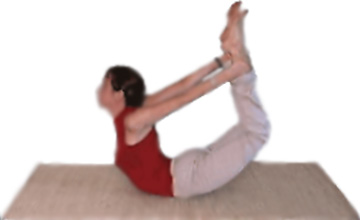
Posture:Dhanura–asana–The Bow Pose
Translation:The Sanskrit word dhanur means bow-shaped, curved or bent. The bow referred is a bow as in "bow and arrow." This asana is so named because the body mimics the shape of a bow with its string stretched back ready to shoot an arrow.
Pronunciation:dha-noor-ah-sa-na
Difficulty:(5)
Instructions:
- Lie flat on the back in the shava-asana (corpse pose).
- Lie on the stomach with the head turned to one side and the arms alongside the body with palms facing upward.
- Turn the head and place the chin on the floor. Exhale, bend the knees, reach back with the arms and grasp the right ankle with the right hand and the left ankle with the left hand.
- While inhaling, slowly raise the legs by pulling the ankles up and raising the knees off the floor while simultaneously lifting the chest off the floor. Hold the inhale breath. The weight of the body should be resting on the abdomen.
- Tilt the head as far back as possible. Hold the posture as long as you can comfortably hold the inhale breath
- Slowly exhale bringing the knees to the floor, release the ankles, slowly bring the legs and arms straight down on the floor and turn the head to one side, assuming the prone posture you began with.
Comments:
The most obvious benefit of the dhanur-asana is that it restores flexibility to the spine. Regular practice will relieve lower back pain and release tension and strain in the upper back and neck area. The alternating stretching and releasing of the abdominal muscles increases blood flow to this area and aids all sorts of digestive disorders and discomforts. Strain or fatigue in the legs is also released after a few repetitions. Extended practice will help develop upper-body strength.
Duration/Repetitions:
The dhanur-asana is either held for the duration of the inhaled or between one and three minutes while breathing gently through the nostrils. Repeat it two or three times.
Variations:
The two variations of the dhanur-asana have to do with the method of breathing and the amount of arch of the back. As one progresses with this asana and is able to hold the posture for a longer period of time, the posture can be held while slow, rhythmic breathing is maintained through the nostrils. As the spine becomes more flexible try drawing the feet closer to the head. Some are able to join the top of the head to the soles of the feet although this is certainly not necessary to accomplish the dhanur-asana.


